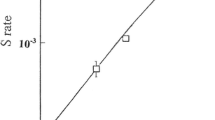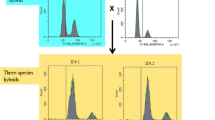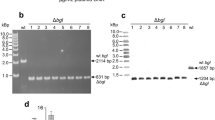Summary
Off the transconjugants formed in theR. lupini conjugation 0.5 to 5% are merodiploids. When two differently pigmented parents are used in the crossing experiment the diploid transconjugants can be differentiated from the haploid recombinants by their additive pigmentation type. The segregation patterns of these diploid clones were analyzed. The results are in agreement with the theory that the exogenotic donor DNA can be integrated at different sites of the homologous recipient chromosomal region forming a tandem sequence. Consequently the segregants of these merodiploid clones are formed by endochromosomal recombination.
Similar content being viewed by others
References
Audit, C., Anagnostopoulos, C.: Studies on the size of the diploid region inBacillus subtilis merozygotes from strains carrying thetrp E26 mutation. Molec. gen. Genet.137, 337–351 (1975)
Heumann, W.: Conjugation in starformingRhizobium lupini. Molec. gen. Genet.102, 132–144 (1968)
Heumann, W., Pühler, A., Wagner, E.: The two transfer regions of theRhizobium lupini conjugation. I. Fertility factor elimination and one way transfer. Molec. gen. Genet.113, 308–315 (1971)
Heumann, W., Pühler, A., Wagner, E.: The two transfer regions of theRhizobium lupini conjugation. II. Genetic characterization of the transferred chromosomal segments. Molec. gen. Genet.126, 267–274 (1973)
Johnson, E.M., Falkow, S., Baron, L.S.: Recipient ability ofSalmonella typhosa in genetic crosses withEscherichia coli. J. Bact.87, 54–60 (1964)
Johnson, E.M., Placek, B.P., Snellings, Norma J., Baron, L.S.: Conservation ofSalmonella typhimurium deoxyribonucleic acid by chromosomal insertion in a partially diploidEscherichia coli hybrid. J. Bact.123, 1–6 (1975)
Kashmiri, S.V.S., Hotchkiss, R.D.: Evidence of tandem duplication of genes in a merodiploid region of pneumococcal mutants resistant to sulfonamide. Genetics81, 21–31 (1975)
Lederber, J.: Aberrant heterozygotes inEscherichia coli. Proc. nat. Acad. Sci. (Wash.)35, 178–184 (1949)
Morse, M.L., Lederberg, Esther M., Lederberg, J.: Transductional heterogenotes inEscherichia coli. Genetics41, 758–779 (1956)
Tucher, R.: Untersuchungen an RP4-DNA in Minizellen vonRhizobium lupini. Dissertation, Erlangen, 1974
Wohlhieter, J.A., Gemski, P., Jr., Baron, L.S.: Extensive segments of theEscherichia coli K12 chromosome inProteus mirabilis diploids. Molec. gen. Genet.139, 93–101 (1975)
Author information
Authors and Affiliations
Additional information
Communicated by F. Kaudewitz
This work was supported by the Deutsche Forschungsgemeinschaft and Stiftung Volkswagenwerk.
Rights and permissions
About this article
Cite this article
Heumann, W., Springer, R. Formation of merodiploid clones by conjugation inRhizobium lupini . Molec. Gen. Genet. 150, 73–79 (1977). https://doi.org/10.1007/BF02425327
Received:
Accepted:
Issue Date:
DOI: https://doi.org/10.1007/BF02425327




